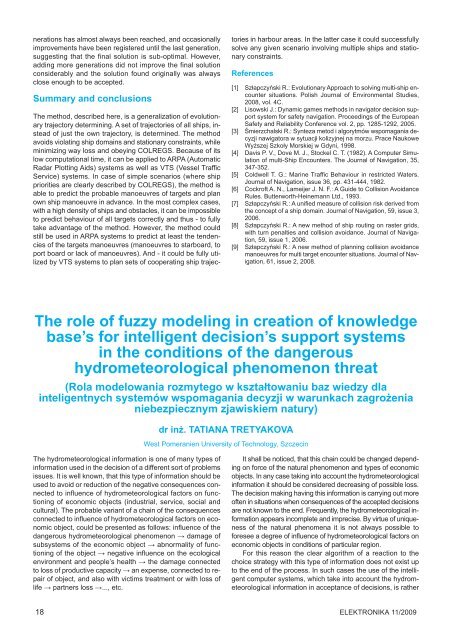Elektronika 2009-11.pdf - Instytut Systemów Elektronicznych
Elektronika 2009-11.pdf - Instytut Systemów Elektronicznych
Elektronika 2009-11.pdf - Instytut Systemów Elektronicznych
You also want an ePaper? Increase the reach of your titles
YUMPU automatically turns print PDFs into web optimized ePapers that Google loves.
nerations has almost always been reached, and occasionally<br />
improvements have been registered until the last generation,<br />
suggesting that the final solution is sub-optimal. However,<br />
adding more generations did not improve the final solution<br />
considerably and the solution found originally was always<br />
close enough to be accepted.<br />
Summary and conclusions<br />
The method, described here, is a generalization of evolutionary<br />
trajectory determining. A set of trajectories of all ships, instead<br />
of just the own trajectory, is determined. The method<br />
avoids violating ship domains and stationary constraints, while<br />
minimizing way loss and obeying COLREGS. Because of its<br />
low computational time, it can be applied to ARPA (Automatic<br />
Radar Plotting Aids) systems as well as VTS (Vessel Traffic<br />
Service) systems. In case of simple scenarios (where ship<br />
priorities are clearly described by COLREGS), the method is<br />
able to predict the probable manoeuvres of targets and plan<br />
own ship manoeuvre in advance. In the most complex cases,<br />
with a high density of ships and obstacles, it can be impossible<br />
to predict behaviour of all targets correctly and thus - to fully<br />
take advantage of the method. However, the method could<br />
still be used in ARPA systems to predict at least the tendencies<br />
of the targets manoeuvres (manoeuvres to starboard, to<br />
port board or lack of manoeuvres). And - it could be fully utilized<br />
by VTS systems to plan sets of cooperating ship trajectories<br />
in harbour areas. In the latter case it could successfully<br />
solve any given scenario involving multiple ships and stationary<br />
constraints.<br />
References<br />
[1] Szłapczyński R.: Evolutionary Approach to solving multi-ship encounter<br />
situations. Polish Journal of Environmental Studies,<br />
2008, vol. 4C.<br />
[2] Lisowski J.: Dynamic games methods in navigator decision support<br />
system for safety navigation. Proceedings of the European<br />
Safety and Reliability Conference vol. 2, pp. 1285-1292, 2005.<br />
[3] Śmierzchalski R.: Synteza metod i algorytmów wspomagania decyzji<br />
nawigatora w sytuacji kolizyjnej na morzu. Prace Naukowe<br />
Wyższej Szkoły Morskiej w Gdyni, 1998.<br />
[4] Davis P. V., Dove M. J., Stockel C. T. (1982). A Computer Simulation<br />
of multi-Ship Encounters. The Journal of Navigation, 35,<br />
347-352.<br />
[5] Coldwell T. G.: Marine Traffic Behaviour in restricted Waters.<br />
Journal of Navigation, issue 36, pp. 431-444, 1982.<br />
[6] Cockroft A. N., Lameijer J. N. F.: A Guide to Collision Avoidance<br />
Rules. Butterworth-Heinemann Ltd., 1993.<br />
[7] Szłapczyński R.: A unified measure of collision risk derived from<br />
the concept of a ship domain. Journal of Navigation, 59, issue 3,<br />
2006.<br />
[8] Szłapczyński R.: A new method of ship routing on raster grids,<br />
with turn penalties and collision avoidance. Journal of Navigation,<br />
59, issue 1, 2006.<br />
[9] Szłapczyński R.: A new method of planning collision avoidance<br />
manoeuvres for multi target encounter situations. Journal of Navigation,<br />
61, issue 2, 2008.<br />
The role of fuzzy modeling in creation of knowledge<br />
base’s for intelligent decision’s support systems<br />
in the conditions of the dangerous<br />
hydrometeorological phenomenon threat<br />
(Rola modelowania rozmytego w kształtowaniu baz wiedzy dla<br />
inteligentnych systemów wspomagania decyzji w warunkach zagrożenia<br />
niebezpiecznym zjawiskiem natury)<br />
dr inż. TATIANA TRETYAKOVA<br />
West Pomeranien University of Technology, Szczecin<br />
The hydrometeorological information is one of many types of<br />
information used in the decision of a different sort of problems<br />
issues. It is well known, that this type of information should be<br />
used to avoid or reduction of the negative consequences connected<br />
to influence of hydrometeorological factors on functioning<br />
of economic objects (industrial, service, social and<br />
cultural). The probable variant of a chain of the consequences<br />
connected to influence of hydrometeorological factors on economic<br />
object, could be presented as follows: influence of the<br />
dangerous hydrometeorological phenomenon → damage of<br />
subsystems of the economic object → abnormality of functioning<br />
of the object → negative influence on the ecological<br />
environment and people’s health → the damage connected<br />
to loss of productive capacity → an expense, connected to repair<br />
of object, and also with victims treatment or with loss of<br />
life → partners loss →..., etc.<br />
It shall be noticed, that this chain could be changed depending<br />
on force of the natural phenomenon and types of economic<br />
objects. In any case taking into account the hydrometeorological<br />
information it should be considered decreasing of possible loss.<br />
The decision making having this information is carrying out more<br />
often in situations when consequences of the accepted decisions<br />
are not known to the end. Frequently, the hydrometeorological information<br />
appears incomplete and imprecise. By virtue of uniqueness<br />
of the natural phenomena it is not always possible to<br />
foresee a degree of influence of hydrometeorological factors on<br />
economic objects in conditions of particular region.<br />
For this reason the clear algorithm of a reaction to the<br />
choice strategy with this type of information does not exist up<br />
to the end of the process. In such cases the use of the intelligent<br />
computer systems, which take into account the hydrometeorological<br />
information in acceptance of decisions, is rather<br />
18 ELEKTRONIKA 11/<strong>2009</strong>

















